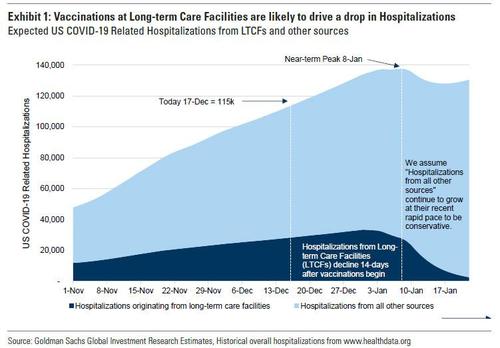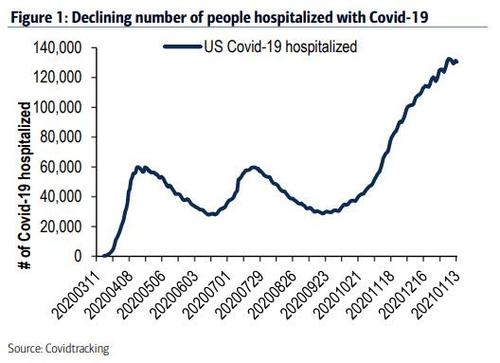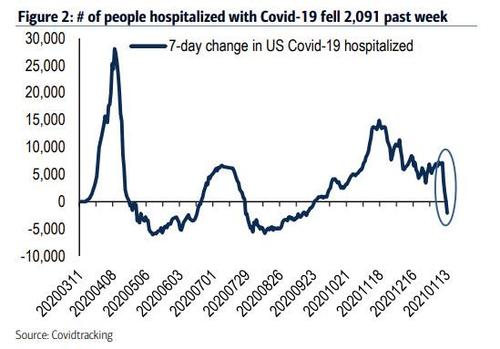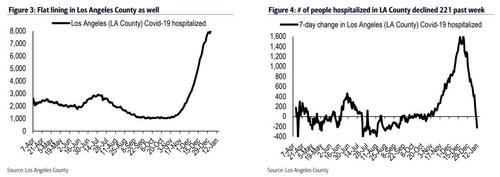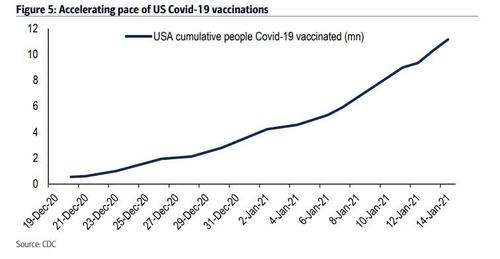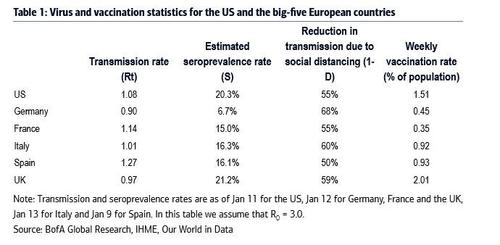Feature your business, services, products, events & news. Submit Website.
Breaking Top Featured Content:
One Bank Makes A Big Call: “Vaccinations Should Bring Virus Under Control In Next Few Weeks”
One month ago, we presented to our readers an analysis from Goldman Sachs, according to which the rapid rollout of vaccinations at long-term care facilities would lead to a decline in US hospitalizations around Jan 9, and would then push total covid-related hospitalizations to nearly zero by the end of the month.
While Goldman may have been off by a few days, it was almost spot on: as Bloomberg reported earlier this week, citing the Covid Tracking Project, the US hospitalization numbers are now dropping compared with a week earlier in both the Northeast and Midwest, the critical inflection point that Goldman had pegged for Jan 9.
An analysis from BofA confirms this critical inflection point. According to the bank, we saw a 2,091 person decrease in the number of people hospitalized in the US with Covid-19 over the last week, the first decline since September 23rd.
Considering that just four days ago there was a 7,167 person weekly increase and since then the number has declined gradually..
… this is a huge improvement. While the decrease is broad based (31 of 51 states+DC), the decline in weekly change of course is dominated by CA, FL, GA, NY and TX. Further inspection shows continued improvement in the fall outbreak states (mainly in Midwest) and stabilization in some of the worst more recent winter outbreaks, such as in Los Angeles County that saw a weekly decline of 221 after having peaked at an increase of 1,612 on December 22nd.
All this is happening just as Biden is about to be inaugurated: what an amazing coincidence!
Convenient timing aside, there is now even more good news. In a note published overnight by BofA’s Aditya Bhave, the economist makes a big call which just happens to coincide with what Goldman predicted one month ago. Namely, according to Bhave, “If the new strains do not spread in the US, vaccination should bring the virus under control in the next few weeks.”
Of course, that is a rather large caveat considering the CDC just warned that the Covid-19 variant that emerged in the U.K. and sparked concerns of faster spread could become dominant in the U.S. as soon as March (just in case anyone thought that the Fed would slow down its brrrrrrrr any time soon).
We dig a little deeper, first into BofA’s “upside case” which sees covid disappearing in just a few weeks. This is what the bank had to say on that:
A relatively simple framework can capture the impact of several factors that drive the rate of transmission of the virus. Keep in mind that a transmission rate of one – each infected person infects one other person – means stable cases and rates above/below one mean rising/falling cases.
The transmission rate of the virus (Rt) in a given country or region can be calculated as the product of three things:
- The “natural” transmission rate (R0) absent any containment measures.
- The impact of social distancing (D).
- The share of the population that is not immune to the virus (1-S). The technical term for “S” is the seroprevalence rate.
How do vaccinations impact the transmission rate?
BofA expects the pace of vaccination in the US to soon increase to 1 million per day, or 2.1% of the population per week.
Not all of these doses will create additional immunity in the population because the first dose is expected to have around 80% efficacy according to Pfizer, and some doses are being given to people who already have immunity. The bank then calculates that at a rate of 1mn doses per day, about 1.4% of the population would gain immunity each week. Note that this number will drop significantly when a large share of vaccines being administered are second rather than first doses, since the second dose is estimated to increase efficacy by only around 15 percentage points, from 80% to 95%.
With 1.4% of the population gaining immunity each week, the transmission rate Rt should drop by 1.9% (=1.36*1.4%) every week. This is in addition to the decline from increased social distancing because of the end of the holidays. All else being equal, this means we should see significant drops in case counts in the coming weeks, followed with a lag in hospitalizations and fatalities.
“Are we nearly out of the woods?” BofA asks rhetorically… although the answer is likely no if the CDC is right and a new, more contagious virus becomes dominant (which it probably will just to allow politicians to slam through even more trillions in stimulus). In that case Bhave believes that “the best hope might be to quickly vaccinate the vulnerable and accept higher case counts among the healthy.
So while covid may be a distant memory in a few months – if the mutant covid strain fails to become the prevalent one – here are Bhave’s thoughts on the worst case scenario:
The lingering concern is that much more contagious mutations of the virus out of the UK and South Africa are starting to spread across the world. The UK and South Africa strains are estimated to be at least 50% more contagious. A 50% increase in the underlying transmission rate would lead to a massive new surge, in spite of the vaccination drive. To offset it, we would have to inoculate an additional 33% of the population. This would take over six months at the 1mn-shots-per-day pace, and the economic damage during that period would be massive.
In other words, the fate of the outlook largely depends on how quickly the more contagious strains start to dominate, and how much the transmission rate actually increases. One reason for hope is that the US is a very large and relatively sparsely-populated country. It might take much longer for the new strain to become dominant than it did in the UK, particularly with the post-holiday slump in travel.
This could buy time for vaccinations to gather speed. In an optimistic scenario, the US could administer first doses to another 40mn people by the end of February, increasing population-wide immunity by around 8 percentage points. That is only a quarter of what is needed to offset the full estimated impact of the UK strain. Importantly, however, the shots over the next few weeks will largely be allocated to the most vulnerable people. With another 40mn shots, we think more than half of the population over 65 would have been vaccinated. This should significantly reduce the number of severe cases, and thus the strain on the healthcare system.
In short, there is a distinct possibility that covid will very soon be a distant memory, just as Biden is inaugurated in front of 21,000 heavily armed national guardsmen… and even if the more virulent strain spreads, it would at most delay V-day by just a few months.
Tyler Durden
Fri, 01/15/2021 – 14:49
Continue reading at ZeroHedge.com, Click Here.

